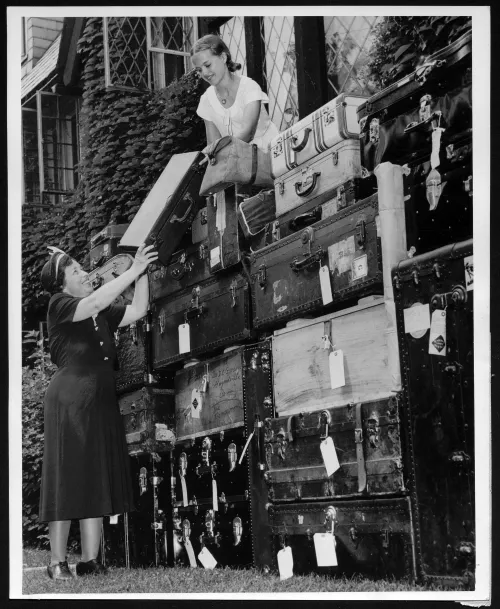This month in Presbyterian history
A family feature, an overseas trip, a hospital is dedicated — and more

In late June of 1903, the Philadelphia Press published an article about a Scotch-Irish family known popularly as the “Fighting McCooks.” The article offers a genealogical history of the family, “one of the most remarkable families in the United States … contributing sixteen members … to the Union Army during the Civil War, of whom all but one were commissioned officers,” while also highlighting the life and work of the Rev. Dr. Henry C. McCook, a Philadelphia pastor.

Henry C. McCook (1837-1911) was one of the 15 McCook men to fight for the Union. Following the outbreak of the Civil War, McCook left Western Theological Seminary in Pittsburgh and enlisted as first lieutenant in the 41st Illinois Infantry. He was appointed as chaplain of the regiment, a position he held for nine months before resigning from military service. In 1869, he became pastor of Seventh Presbyterian Church of Philadelphia, which merged with Sixth Presbyterian in 1873 to become Tabernacle Presbyterian. In 1898, McCook was appointed president of the Presbyterian Historical Society, a position he served in until his death in 1911.

They’re all packed! Late June 1949 saw Mrs. Donald Gordon and her daughter, Alma, scaling the side of a mountain of their own making — Mount LuggagA missionary’s luggage, June 27, 1949. [Pearl ID:415963].e, seen here, is made up of 12 trunks, 9 suitcases, and 2 boxes. Where are they headed with so much in tow? The Gordons are off to reunite with their patriarch, Dr. Donald Gordon, in Brazil, where he serves as director of the Presbyterian-sponsored hospital at Rio Verde. Don’t fret — they haven’t packed up the entire house. Rather, the majority of Mount Luggage contains used clothing collected by Mrs. Gordon on behalf of the nurses employed at the hospital in Brazil.

On June 18, 1952, Dr. John C. Smith attended the dedication ceremony for the Taegu Presbyterian Hospital’s new Nurse’s School building. The Presbyterian Church's foreign missionary enterprise in the 19th century was responsible for the establishment of educational facilities, hospitals, orphanages, seminaries and other institutions that reflected the church's educational, medical and evangelical ministry. The missionary operation continued to expand in the 20th century when Dr. John Coventry Smith (1903-1984) began his missionary service. He traveled to Japan after graduating from Pittsburgh Theological Seminary in 1928. In the early 1950s, Smith served as associate general secretary of the United Presbyterian foreign mission board — a position that had him traveling to various sites throughout the world, including his trip to the Taegu Presbyterian Hospital in Korea in 1952. In 1959, Smith became general secretary of the agency, which had been renamed the Commission on Ecumenical Mission and Relations. From 1968 to 1975, he served as the president of the World Council of Churches. The year he took this position, Smith was also elected moderator of the United Presbyterian Church in the U.S.A.

In June 1962, Presbyterian Life published a special report titled “Troubleshooters of the Racial Crisis” that chronicled the work of two UPCUSA ministers, J. Metz Rollins (1926-2009) and John H. Marion. From 1958 through 1963, Rollins and Marion traveled throughout the Southern states to speak with church communities about racial justice and civil rights. They counseled with pastors, assisted in setting up programs of Christian action, and visited civil rights activists in jail, all with the mission of demonstrating that the UPCUSA stood for an integrated church and society.
Before working alongside Marion for the UPCUSA, Rollins was the founding pastor of Trinity Presbyterian Church (PCUS) in Tallahassee, Florida, the city’s first Black Presbyterian congregation. There, he became involved in the Tallahassee bus boycott and other nonviolent resistance efforts against racial segregation. Rollins was detained several times for his activism. In 1960, he was arrested for participating in lunch counter sit-ins; in Mississippi in 1961, he was arrested for his involvement in the Freedom Rides movement. In 1964, after his service with the UPCUSA’s civil rights organization came to an end, Rollins moved to New York. Three years later, he became the first executive director of the National Committee of Black Churchmen, an organization dedicated to advocating for racial awareness within churches. In 1972, Rollins accepted a call to serve as pastor of St. Augustine Presbyterian Church in the Bronx, which he served for more than 30 years.

June 1989 saw the PC(USA) General Assembly hold its bicentennial celebration in Philadelphia at the Presbyterian Historical Society. Perhaps the highlight of the celebration was the ceremonial burying of a time capsule at the building at 425 Lombard Street.
In 1989, when the PC(USA) General Assembly held its 200-year anniversary meeting in Philadelphia, a planned time capsule was placed in the front yard, in the base of a sundial. PHS director William Bayard Miller and PHS board chair George Laird Hunt led the ceremony, placing printed materials, including an issue of the Presbyterian Outlook, into the canister.
It remained there, undisturbed, until 2016, when alterations to PHS’s Heritage Walk forced the capsule’s relocation. The capsule was removed while construction continued, weighed (42.2 pounds!), and placed in temporary storage until it could be returned to its resting place, unopened. In June 2039, at the 250-year anniversary, the capsule’s seal will be broken for the first time and a new group of PHS caretakers, volunteers, and researchers will look inside. Only 14 years to go!
You may freely reuse and distribute this article in its entirety for non-commercial purposes in any medium. Please include author attribution, photography credits, and a link to the original article. This work is licensed under a Creative Commons Attribution-NonCommercial-NoDeratives 4.0 International License.




